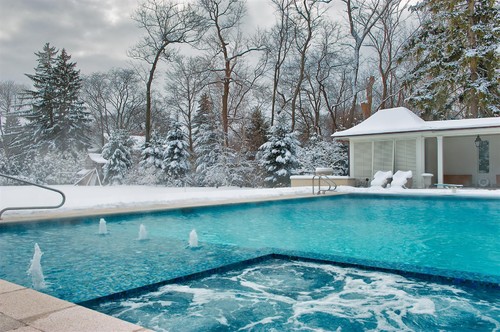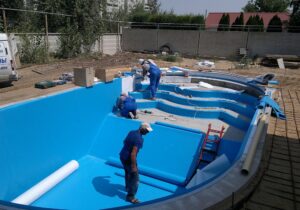Did you know that neglecting your pool during the chilly Pennsylvania winters can cost you thousands in repairs come spring? It’s true—frozen pipes, cracked tiles, and murky water are just a few of the headaches waiting for homeowners who skip proper pool winterization. But don’t worry, you’ve got this! By following some straightforward Seasonal Pool Care and pool winterization tips, you can protect your backyard oasis and save yourself a big headache (and bill) when the thaw hits. In this guide, you’ll learn how to prep your pool like a pro, keep it safe through the frosty months, and ensure it’s ready to dazzle when summer rolls back around—all tailored to the unique needs of homeowners in Pennsylvania.

Why Winterizing Your Pool Matters
Let’s face it: Pennsylvania winters aren’t gentle. With temperatures dipping below freezing and snow piling up, your pool is at the mercy of the elements. Without proper care, water left in your pipes can freeze and expand, leading to costly damage. Plus, stagnant water becomes a breeding ground for algae and bacteria—not exactly the vibe you want when you uncover your pool in May. Winterizing isn’t just about closing your pool; it’s about preserving the investment you’ve made in your outdoor space. At Poseidon’s Custom Pools, we’ve seen firsthand how a little prep now can mean a lot less stress later.
So, what’s the game plan? You’ll need to clean, balance, drain, and cover your pool step-by-step. Let’s dive into the details.
Step 1: Clean Your Pool Thoroughly
Before you even think about closing up shop, give your pool a good scrub. Debris like leaves, twigs, and dirt can stain your pool’s surface or clog your filter if left sitting all winter. Grab your skimmer net and scoop out anything floating around. Then, brush the walls and floor to loosen up any algae or grime. Finish with a vacuum to suck up the last bits of mess.
Got a stubborn spot? A pool-safe cleaner can help, but don’t go overboard—stick to products designed for your pool type (inground or above-ground). A clean pool now means less elbow grease when you reopen it.
Pro Tip: If you’ve got trees dropping leaves like confetti, consider skimming daily in the week leading up to winterization. It’s a small effort that pays off big.
Step 2: Balance Your Water Chemistry
Next, let’s talk water. You might think, “It’s just sitting there all winter—what’s the big deal?” Well, unbalanced water can corrode your pool’s equipment or leave behind scale buildup. Test your water with a kit (available at most hardware stores) and aim for these levels:
- pH: 7.2–7.6
- Alkalinity: 80–120 ppm
- Calcium Hardness: 200–400 ppm
If your numbers are off, adjust with the right chemicals—pH increaser or decreaser, alkalinity booster, or calcium chloride. Once balanced, add a winterizing chemical kit. These kits typically include an algaecide and a shock treatment to keep your water quality clear and algae-free through the cold months. Follow the instructions carefully—too much shock can bleach your liner, and nobody wants that surprise in spring.
Step 3: Lower the Water Level and Drain Equipment
Now, it’s time to get that water level just right. For inground pools in Pennsylvania, drop the water below the skimmer line—usually about 4–6 inches below the tile. Above-ground pools? Lower it 18 inches below the skimmer. This prevents freezing water from damaging your skimmer or pipes.
After that, drain your pump, filter, and heater. Use a shop vac to blow out any remaining water from the lines—frozen pipes are a nightmare you don’t want to deal with. Add pool antifreeze (non-toxic, of course) to the plumbing lines for extra protection. It’s a simple step that can save you from a cracked pipe when the thermometer hits single digits.
Quick Note: Not sure how much to lower the water? Check your pool’s manual or give us a shout at Poseidon’s Custom Pools—we’re happy to guide you.
Step 4: Cover It Up Right
A solid pool cover is your best defense against Pennsylvania’s snow, ice, and wind. But not all covers are created equal. Here’s a quick breakdown:
| Cover Type | Pros | Cons |
| Solid Cover | Keeps out debris and sunlight | Can collect water on top |
| Mesh Cover | Lets rain through, less pooling | Allows some debris in |
| Safety Cover | Super durable, kid- and pet-safe | Pricier upfront |
For most homeowners in Pennsylvania, a safety cover is worth the investment—especially if you’ve got little ones or furry friends roaming the yard. Secure it tightly with straps or anchors, and double-check for gaps where leaves could sneak in. If you go with a solid cover, use a cover pump to remove standing water after storms. Want more pool safety tips? There’s plenty to explore!
Pool protected with a safety cover during a snowy Pennsylvania winter—smart pool winterization tips in action!
Step 5: Store Accessories and Check Equipment
Don’t forget the little things! Remove ladders, diving boards, and toys, then store them somewhere dry—your garage or shed works great. Clean your filter (backwash it if it’s a sand filter) and store it indoors if possible. Pennsylvania’s damp winters can rust metal parts, so a quick spray of lubricant on your pump’s metal bits can keep it in top shape.
Wondering if your equipment’s up to snuff? Winter’s a great time to schedule a check-up with a pro. At Poseidon’s Custom Pools, we’ve helped tons of homeowners spot small issues before they turn into big repair bills.

FAQs About Pool Winterization
How late can I winterize my pool?
Aim to close it when nighttime temps consistently hit the 40s—usually late October or early November in Pennsylvania. Too late, and you risk freeze damage; too early, and algae might sneak in.
Can I skip the cover?
You could, but you’d be inviting debris, critters, and UV damage. A cover saves you time and money in the long run.
What if I don’t drain the lines?
Frozen water expands and cracks pipes. Trust me, replacing plumbing in March isn’t fun—or cheap.
Winter Pool Care Made Simple
Winterizing your pool doesn’t have to feel like a chore. Start with a clean slate, balance your water, lower the level, and lock it down with a sturdy cover. Store your gear, protect your equipment, and you’re golden. These pool winterization tips are all about keeping your pool safe and sound through Pennsylvania’s harsh winters, so you can jump back in without a hitch when the sun returns.
Ready to make your pool winter-ready? Grab your supplies, follow these steps, and rest easy knowing you’ve got it covered—literally. Got questions or need a hand? Drop a comment below or share this post with a fellow pool owner. Better yet, reach out to Poseidon’s Custom Pools for expert help—we’re here to make your pool dreams last all year long!






